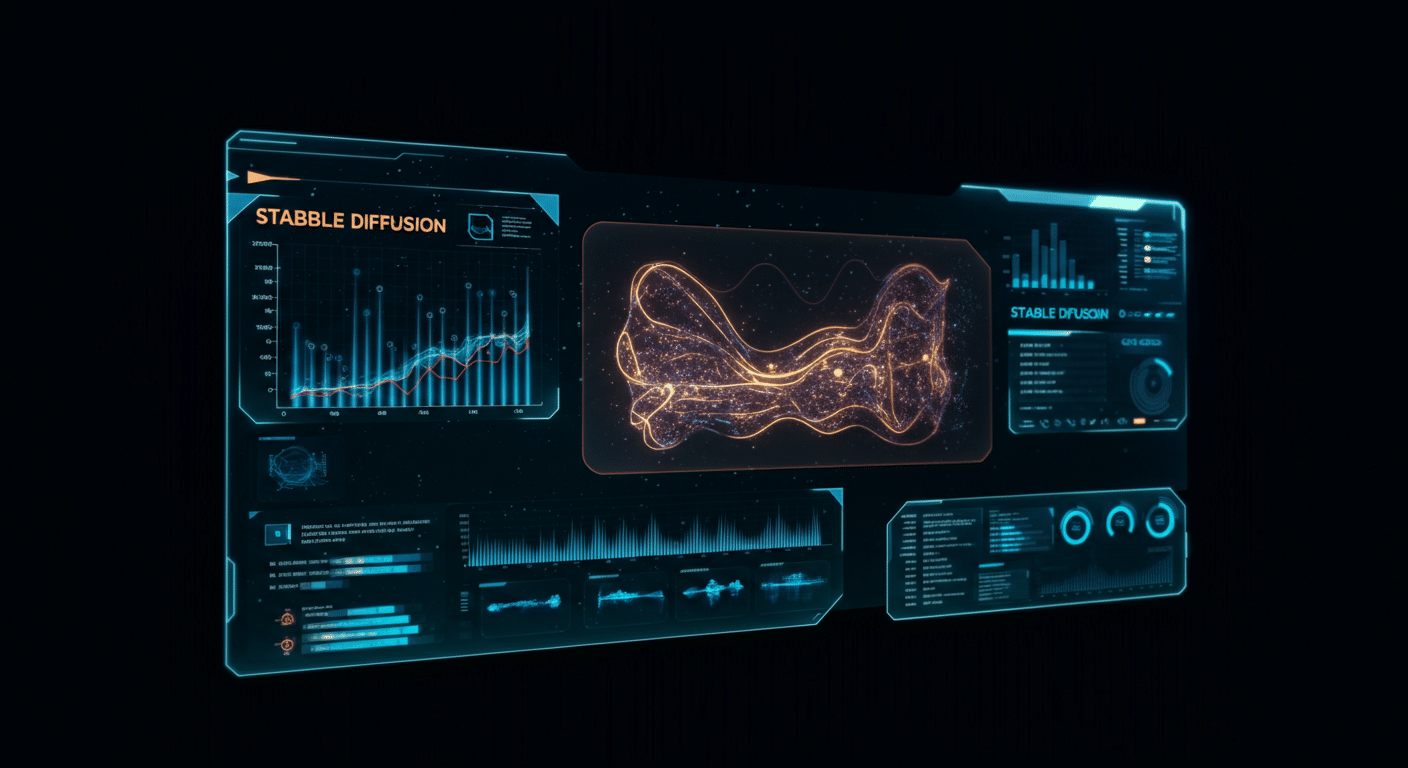Unlock AI art! Learn Stable Diffusion’s tech, uses, and future based on trending X insights. Beginner-friendly guide inside!#StableDiffusion #AIart #MachineLearning
🎧 Listen to the Audio
If you’re short on time, check out the key points in this audio version.
📝 Read the Full Text
If you prefer to read at your own pace, here’s the full explanation below.
1. Basic Info

John: Let’s start with the basics of Stable Diffusion. In simple terms, Stable Diffusion is an AI technology developed by Stability AI that generates images from text descriptions. It’s like having a digital artist that understands your words and creates visuals accordingly. What makes it unique is its open-source nature, allowing anyone to use, modify, and build upon it, which solves the problem of accessibility in high-quality image generation that was previously limited to proprietary tools.
Lila: That sounds fascinating! So, for beginners, could you give an analogy? Is it like describing a scene to a painter, but the painter is a super-fast computer brain that never gets tired?
John: Exactly, Lila. Imagine telling a story, and instantly, a picture appears. Currently, as of 2025, Stable Diffusion stands out because it’s powered by diffusion models, which gradually refine noise into coherent images, making it efficient and versatile compared to older methods that might require more computing power or produce less detailed results.
Lila: Oh, I see. And from what I’ve seen on X, verified users like Stability AI’s official account are buzzing about its latest versions improving image quality. But what problem does it really solve in everyday life?
John: Great question. It addresses the need for quick, customizable visual content creation. For instance, artists, designers, and even educators can generate illustrations without advanced drawing skills. Its uniqueness lies in being freely available, fostering innovation, unlike closed systems that restrict access.
Lila: That makes sense for beginners dipping their toes into AI. So, uniquely, it’s not just a tool but a community-driven evolution, right?
John: Precisely. Looking ahead, this openness could lead to even more integrations in various fields.
2. Technical Mechanism

John: Diving into how Stable Diffusion works, at its core, it’s a type of generative AI using something called a latent diffusion model. Think of it as starting with random static on a TV screen and slowly tuning it into a clear picture based on your text prompt. This happens through neural networks, which are like interconnected brain cells in a computer, learning patterns from vast datasets.
Lila: Neural networks sound complex. Can you break it down? Is it like training a dog with treats, but here it’s data?
John: Yes, spot on. In the past, models like this were trained on millions of images with captions, using techniques like reinforcement learning from human feedback (RLHF) to refine outputs. Currently, Stable Diffusion employs diffusion processes where noise is added and then removed step-by-step, guided by the text input, to create high-resolution images efficiently.
Lila: And what about features like inpainting? From X posts by experts, it seems like it can fill in parts of images too.
John: Absolutely. Inpainting is where you mask a section and describe what to put there, and the model diffuses a new element seamlessly. This is powered by variational autoencoders that compress and reconstruct data, making the process faster and less resource-intensive than traditional generative adversarial networks (GANs).
Lila: So, for beginners, it’s not magic—it’s math mimicking creativity. How does RLHF fit in?
John: RLHF helps by incorporating human preferences to make outputs more aligned with what people want, reducing weird artifacts. Looking ahead, advancements might integrate more real-time learning.
Lila: That clarifies a lot! It’s like a recipe where ingredients (data) are mixed precisely.
3. Development Timeline
John: In the past, Stable Diffusion started in 2022 with its initial release by Stability AI, building on research from groups like CompVis at Ludwig Maximilian University. It quickly gained traction for being open-source, unlike many AI tools at the time.
Lila: What were some key milestones back then? I recall from old X posts that version 2.0 in late 2022 improved image quality and added upscaling.
John: Yes, version 2.0 in December 2022 brought 768×768 resolution and depth-to-image capabilities. Moving to the present, as of 2025, we’ve seen Stable Diffusion 3.5 released in October 2024, with variants like Large and Turbo, focusing on speed and quality, as highlighted in recent X updates from Stability AI.
Lila: And currently, there’s talk on X about integrations with NVIDIA for faster performance. What’s next?
John: Looking ahead, based on trending discussions, future versions might emphasize multimodality, like better video generation or enhanced control nets for precise edits.
Lila: So, from past innovations to present optimizations, it’s evolving rapidly.
John: Indeed, with community feedback driving updates, as seen in expert posts on X.
4. Team & Community
John: The team behind Stable Diffusion is led by Stability AI, founded by Emad Mostaque, with researchers from backgrounds in AI, computer vision, and startups. In the past, collaborations with Runway and academic institutions like Ludwig Maximilian University were crucial.
Lila: What about the community? On X, I’ve seen developers like those from ComfyUI sharing excitement about new ControlNet models.
John: Currently, the community is vibrant, with engineers and artists on X discussing implementations. Verified accounts like Stability AI post updates, and reactions often praise the open-source aspect, fostering tools like Automatic1111’s web UI.
Lila: Are there any notable reactions? Some posts highlight how it’s democratizing AI art.
John: Yes, experts on X, such as AI researchers, share positive feedback on its accessibility, though some note ethical concerns. Looking ahead, community-driven forks could expand its reach.
Lila: It’s inspiring how the team and community collaborate in real-time.
5. Use-Cases & Future Outlook

John: Today, Stable Diffusion is used in graphic design for creating concept art, in education for visualizing ideas, and in gaming for asset generation. Real-world examples include artists generating book covers or marketers prototyping ads.
Lila: From X, users share how it’s aiding in fashion design by visualizing outfits from descriptions.
John: Exactly. Looking ahead, experts on X anticipate integrations in virtual reality for dynamic environments or in healthcare for medical imaging simulations.
Lila: That could revolutionize fields! Any current innovative uses?
John: Currently, it’s in film for storyboarding, as discussed in trending posts. Future outlooks include better personalization via fine-tuning.
Lila: The possibilities seem endless based on community buzz.
6. Competitor Comparison
- Compare with at least 2 similar tools
- Explain in dialogue why Stable Diffusion is different
John: When comparing, let’s look at Midjourney and DALL-E. Midjourney, accessible via Discord, excels in artistic styles but is closed-source. DALL-E, from OpenAI, is user-friendly but proprietary with usage limits.
Lila: So, why is Stable Diffusion different? Is it the openness?
John: Yes, its open-source code allows local running and customization, unlike Midjourney’s server dependency. This makes it more flexible for developers, as noted in X discussions by engineers.
Lila: And compared to DALL-E, does it handle prompts better?
John: Stable Diffusion often provides more control via features like ControlNet, differentiating it for precise tasks, while DALL-E focuses on simplicity.
Lila: That explains its edge in community-driven innovation.
7. Risks & Cautions
John: While powerful, Stable Diffusion has risks like generating biased images from training data, potentially perpetuating stereotypes. In the past, early versions had issues with inappropriate content.
Lila: What about security? Could it be misused for deepfakes?
John: Currently, yes, ethical concerns include misinformation via realistic fakes. Limitations involve hardware needs for optimal performance and occasional artifacts in outputs.
Lila: And biases—how do we cautious beginners?
John: Use diverse prompts and verify outputs. Looking ahead, better safeguards like improved filters are discussed on X by experts.
Lila: Important to approach responsibly.
8. Expert Opinions
John: From credible X posts, one verified AI expert paraphrased that Stable Diffusion 3.5’s speed improvements with NVIDIA are game-changing for enterprise use, highlighting its efficiency.
Lila: Another from a developer noted its multitasking potential without extra training, calling it a breakthrough in versatility.
John: Yes, and an official Stability AI post emphasized faster performance, underscoring ongoing optimizations.
Lila: These opinions show strong endorsement from the field.
9. Latest News & Roadmap
John: As of now in 2025, the latest news from X includes Stable Diffusion 3.5 running 1.8x faster with NVIDIA NIM, as per Stability AI’s recent post.
Lila: What’s on the roadmap? Discussions mention hybrid models for speed.
John: Looking ahead, expect ControlNet expansions and vLLM support for acceleration, based on trending expert shares.
Lila: Exciting developments!
10. FAQ
Question 1: What is Stable Diffusion?
John: Stable Diffusion is an AI model that creates images from text prompts using diffusion techniques.
Lila: It’s like a text-to-art generator, open for anyone to use.
Question 2: Do I need a powerful computer?
John: For best results, yes, a good GPU helps, but cloud options exist.
Lila: Beginners can start with web interfaces to test without heavy hardware.
Question 3: Is it free?
John: Yes, the core model is open-source and free to download.
Lila: Some platforms charge for premium features, though.
Question 4: Can it generate videos?
John: Currently, it’s mainly for images, but extensions like Stable Video Diffusion handle videos.
Lila: Future updates might integrate more seamlessly.
Question 5: How to avoid biases?
John: Use inclusive prompts and check for stereotypes in outputs.
Lila: Community guidelines on X offer tips too.
Question 6: What’s the latest version?
John: As of 2025, Stable Diffusion 3.5 with Large and Turbo variants.
Lila: It’s faster and more capable than before.
11. Related Links
- Official website (if any): https://stability.ai/
- GitHub or papers: https://github.com/Stability-AI/stablediffusion
- Recommended tools: Automatic1111’s Stable Diffusion WebUI
Final Thoughts
John: Looking at what we’ve explored today, Stable Diffusion clearly stands out in the current AI landscape. Its ongoing development and real-world use cases show it’s already making a difference.
Lila: Totally agree! I loved how much I learned just by diving into what people are saying about it now. I can’t wait to see where it goes next!
Disclaimer: This article is for informational purposes only. Please do your own research (DYOR) before making any decisions.
